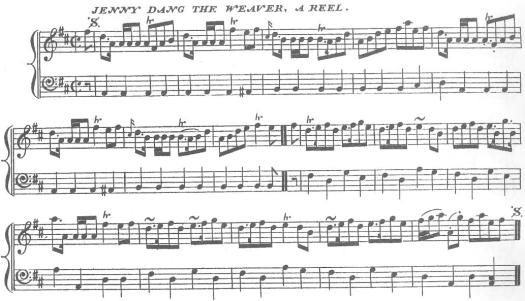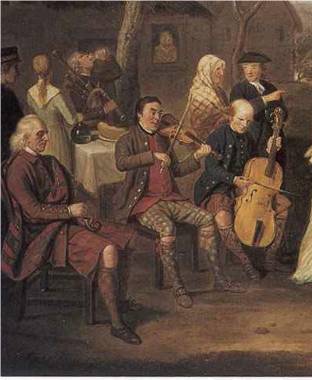La melodia è un reel di origine scozzese è nota anche con i titoli Jenny(Jennie) Dang the Weaver, Patsy Touhey’s Rip The Calico e anche abbinata a due canti in gaelico scozzese “Gobha Bh’ann A Hogha Gearraidh,” e “Horo Ghoid Thu Nighean”
Dare dei titoli a dei brani strumentali richiede sempre uno sforzo d’immaginazione e intorno ai titoli più curiosi sorgono sempre degli aneddoti, proprio come in questo caso:
Composed by the Rev. Alexander Garden [ 1700 ? – 1777 ]. Minister at Birse [ 1726 – 1777 ]. Violinist, poet and composer.
“Mr. Garden had, it seems, a man-of-all work named Jock, who came about the manse to do odd jobs, and on one occasion when the minister was in his study solacing himself with his favourite Cremona, an altercation began between Jock and his mistress, who had ordered him to “wipe the minister’s shoon”. This Jock considered beneath his dignity and sturdily refused to do, which so enraged Mrs. Garden ( who was busy “beetling” potatoes at the time ) that she rushed at him with the heavy beetle in her hand and fairly thrashed him into obedience to her order : and the minister was so diverted with the scene that he gave the air he had just composed the above title as being appropriate, Jock having been a weaver originally”.
Source – “Musical Scotland – 1400 – 1894” by David Baptie (tratto da qui)
ASCOLTA Hanneke Cassel al violino
ASCOLTA Simon Fraser University Pipe Band
Un reel combinato variamente in set per le danze sociali in Scozia, Irlanda, America e Nuova Scozia.
ASCOLTA Cherish The Ladies (inizia a 3.05)
ASCOLTA Matt Malloy & Dervish (da 2:58)
Un arrangiamento che richiama la più antica versione modale si trova in “Repository of the Dance Music” di Niel Gow 1799
Si stralcia da qui
As this tune is in D major, it would be most common for the first chord to be a chord of D with a D in the bass, but as we see here, the bass note is an A which alternates with a B for the first strain. This is a throwback to a modal conception of harmony that was slowly supplanted by tonal major/minor harmony, not taking hold completely in Scotland until well into the nineteenth century. The A-B alternation in the bass is demonstrated in the following video.
Sul reel venne ben presto coreografata anche una scottish country dance dal titolo “Jenny dang the weaver” (Johnson 1748) (già comparsa in “Walsh’s Caledonian Country Dances” edizione del 1735)
E’ stato Sir Alexander Boswell, (1775 — 1822) a scrivere alcuni versi sulla melodia, raccontando di un corteggiatore maldestro e delle sue non gradite attenzioni..
ASCOLTA la versione “classica” arrangiata dal compositore austriaco FJ Haydn – Scottish Songs for George Thomson vol VII 03:13:50
Chorus: Jenny dang(1), Jenny dang / Jenny dang the weaver But soon the fool his folly kent / For Jenny dang the weaver I At Willie’s weddin’ o’ the green, The lasses, bonnie witches, Were busked out(2) in aprons clean, And snaw-white(3) Sunday mutches(4); Auld Mysie(5) bade the lads tak’ tent(6), But Jock wad na believe her; But soon the fool his folly kent, For Jenny dang the weaver. II In ilka country dance and reel Wi’ her he wad be babbin'(7); When she sat down, then he sat down, And till her wad be gabbin’; Where’er she gaed, or butt or ben(8), The coof(9) wad never leave her, Aye cacklin’ like a clockin’ hen, But Jenny dang the weaver. III Quoth he, “My lass, to speak my mind, In troth I needna swither, Ye ‘ve bonnie e’en, and, gif ye ‘re kind, I needna court anither!” He humm’d and haw’d(10), the lass cried ‘pheugh,’ And bade the coof no deave her, Syne crack’d her thumb, and lap and leugh, And dang the silly weaver. |
TRADUZIONE ITALIANO DI CATTIA SALTO (con il dizionario dello Scots aperto qui) coro Gianna picchiò, Gianna picchiò il tessitore, così tosto lo sciocco riconobbe la sua follia perchè Gianna picchiò il tessitore. I Al matrimonio di Willy sul prato le ragazze, belle ammaliatrici indossavano grembiuli candidi e la cuffia bianca della domenica la vecchia Mysie ordinò che i ragazzi prestassero attenzione eppure Gianni non le badava; ma presto lo sciocco riconobbe la sua follia perchè Gianna picchiò il tessitore. II In ogni danza e giro con lei voleva avvolgersi quando lei si sedeva anche lui si sedeva e con lei voleva spettegolare; ovunque lei andasse in lungo e in largo lo sciocco non la voleva mai lasciare schiamazzando come una gallina che starnazza ma Gianna picchiò il tessitore. III Disse lui “Ragazza mia, per dire la mia in verità non ho dubbi, tu sei bella e se sarai carina con me non avrò bisogno di corteggiare un’altra!” Lui tergiversava e la ragazza gridava “puah” e teneva a bada lo sciocco perchè non la infastidisse, finchè lui non le ruppe il pollice, arrossì e rise e lei picchiò lo sciocco tessitore |
NOTE
1) to ding= 1) To knock, beat or strike: to drive; to push suddenly and forcibly; to displace or overturn by shoving 2) To defeat, overcome; wear out, weary; to beat, excel, get the better of.
2) in alcuni testi scritto come a’ dress’d oot che ha molto più senso
3) in alcuni testi scritto come braw white
4) copricapo per signore ovvero una cuffia; il modello varia a seconda delle epoche e delle occasioni per essere indossata, in genere di lino bianco con pizzi e fronzoli ma piuttosto aderente alla testa, si annoda sul davanti sotto il mento. Era portata per lo più dalle donne sposate e veniva regala alla novella sposa dalla suocera

5) diminutivo scozzese di Margaret, ould per old spesso è solo un intercalare
6) espressione idiomatica to take tent =to be careful, beware; to notice, observe, take note; to take good care of; take into consideration, take care of, treat kindly
7) probabilmente bobbin da bobina (spoletta)
8) “butt and ben” è una vecchia frase scozzese per “The back and front ends of a one-room cabin”
9) coof= termina dai molteplici significati quello primario di sciocco, ingenuo, ma anche ottuso; secondariamente significa persona irresponsabile, un cafone o villano nel duplice significato di rozzo, paesano; in ultimo codardo o impiccione
10) espressione idiomatica in americano”to hum and haw”= to be uncertain and take a long time deciding something, si potrebbe tradurre con “tergiversare”
LE CANZONI IN GAELICO
La melodia divenne talmente popolare da essere canticchiata un po’ per tutte le Highland, isole comprese, così la ritroviamo in due diversi frammenti, il contesto è quello del canto come forma di pettegolezzo, nel primo si parla di una fuitina, nel secondo delle prodezze di un fabbro di Hougarry (isole Ebridi)
HORO GHOID THU NIGHEAN
ASCOLTA Mary Jane Lamond in “Suas e!” 1997
I Hò rò ghoid thu ‘n nighean Hò rò ghoid thu ‘n nighean Hò rò shlaod thu i Hò rò ghoid thu ‘n nighean Hò rò ghoid thu ‘n nighean Thug thu leat fo ‘n aodach i II Shiod agad mar ghoid thu ‘n nighean Shiod agad mar ghoid thu ‘n nighean Shiod agad mar shlaod thu i Shiod agad mar ghoid thu ‘n nighean Shiod agad mar ghoid thu ‘n nighean Thug thu leat fo ‘n aodach i |
TRADUZIONE INGLESE I Hòro you stole(1) the girl Hòro you dragged her off Hòro you stole the girl You took her under the bed covers II That’s how you stole the girl That’s how you dragged her off That’s how you stole the girl You took her under the bed covers |
NOTE
1) si tratta con molta probabilità di una fuitina ovvero il rapimento a scopo matrimoniale (vedi)
GOBHA BH’ ANN A HOGHA GEARRAIDH
ASCOLTA Julie Forwlis in Puirt dove canta tre brani in seguenza
a) Siud Mar Chaidh An Càl A Dholaidh
b) Nam Biodh Agam Ghioball Bodaich
c) Gobh Bh’ Ann A Hogha Gearraidh
I Gobha bh’ ann a Hogha Gearraidh(1) B’ fhoghainteach an sealgair e Gobha bh’ ann a Hogha Gearraidh B’ fhoghainteach an sealgair e II Mharbhadh e na feadagan Is leagadh e na calmain Mharbhadh e na feadagan Is leagadh e na calmain |
TRADUZIONE INGLESE I The smith from Hougharry Was a brave hunter The smith from Hougharry Was a brave hunter II He would kill the plover(2) And he would slay the doves He would kill the plover And he would slay the doves |
NOTE
TRADUZIONE ITALIANO: il fabbro di Hougharry era un cacciatore coraggioso, avrebbe ucciso il piviere e i piccioni
1) località nell’isola di North Uist, isole Ebridi
2) il piviere appartiene alla famiglia dei trampolieri, di taglia piccola, è un uccello acquatico per la caccia in palude.
FONTI
http://digital.nls.uk/special-collections-of-printed-music/pageturner.cfm?id=87783252
http://slowplayers.org/2015/02/07/jenny-dang-the-weaver-d/
http://www.musicalion.com/en/scores/sheet-music/329/anonymus/18020/jenny-dang-the-weaver
https://scottishfiddlemusic.com/tag/how-to-play-scottish-fiddle-music/
http://www.poemhunter.com/poem/jenny-s-dang-the-weaver/
https://archive.org/details/JimmieMcLaughlinTheRoadtoGalwayJennyBangtheWeaver
http://www.celticlyricscorner.net/lamond/horoghoid.htm
http://www.celticlyricscorner.net/puirt/gobhabhann.htm
http://www.scottish-country-dancing-dictionary.com/dance-crib/jenny-dang-the-weaver.html
https://my.strathspey.org/dd/dance/3235/
http://ontanomagico.altervista.org/matrimonio-celtico-storia.html



